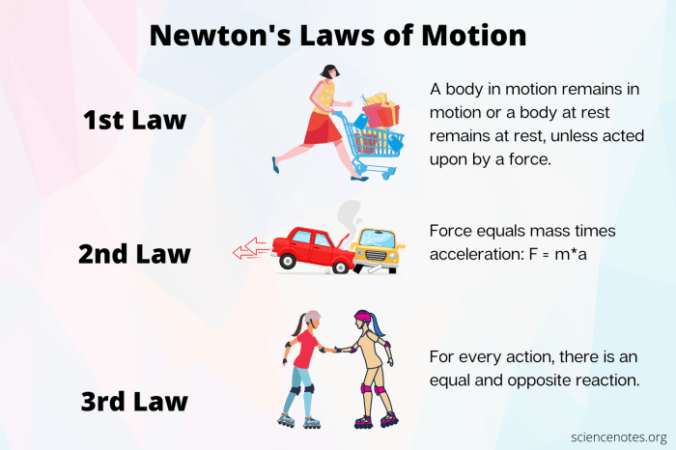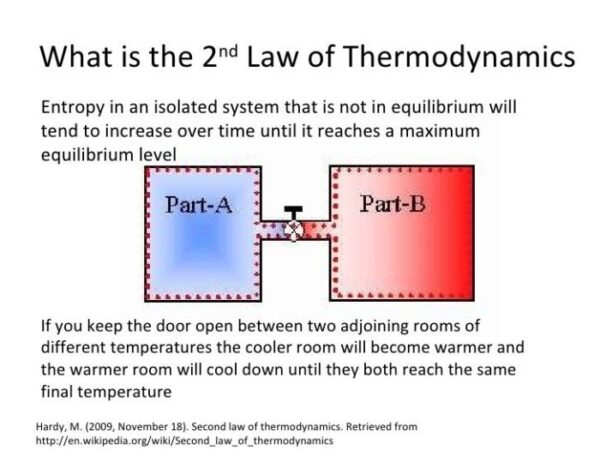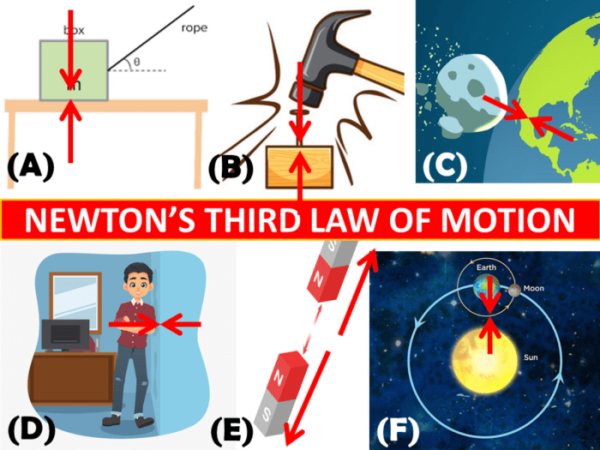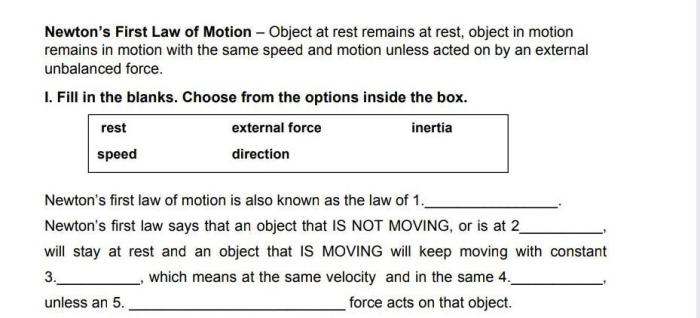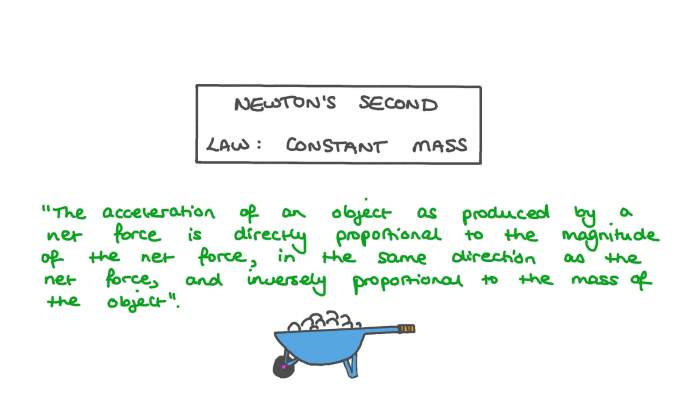
What are Newton’s 3 laws of motion? They are fundamental principles that describe the relationship between force, mass, and motion, forming the bedrock of classical mechanics. These laws, formulated by Sir Isaac Newton in the 17th century, have revolutionized our understanding of how the physical world operates, impacting everything from engineering and physics to everyday experiences.
Newton’s laws explain why objects at rest stay at rest, and objects in motion continue in motion unless acted upon by a force. They demonstrate how force causes objects to accelerate, and that for every action, there is an equal and opposite reaction. These laws are not merely theoretical concepts but have real-world applications, shaping the design of machines, the prediction of motion, and our comprehension of forces in various scenarios.
Introduction to Newton’s Laws of Motion
Newton’s laws of motion are fundamental principles in physics that describe the relationship between the motion of an object and the forces acting upon it. These laws, formulated by Sir Isaac Newton in the 17th century, laid the foundation for classical mechanics and have been instrumental in understanding and predicting the motion of objects in our everyday world.
Newton’s laws revolutionized our understanding of the universe by providing a mathematical framework for describing motion. They are essential for explaining a wide range of phenomena, from the motion of planets around the sun to the behavior of everyday objects like cars and balls.
Force, Mass, and Acceleration
Newton’s laws of motion are based on the concepts of force, mass, and acceleration.
- Force is a push or pull that can cause an object to change its motion. It is measured in units of Newtons (N).
- Mass is a measure of the amount of matter in an object. It is measured in units of kilograms (kg).
- Acceleration is the rate of change of velocity. It is measured in units of meters per second squared (m/s²).
These three concepts are interconnected, as described by Newton’s laws.
Newton’s First Law of Motion
Newton’s First Law of Motion, also known as the Law of Inertia, is a fundamental principle in physics that describes the behavior of objects in motion and at rest. It states that an object at rest will remain at rest, and an object in motion will continue in motion at a constant velocity unless acted upon by a net external force.
Inertia
Inertia is the tendency of an object to resist changes in its state of motion. In simpler terms, it is the object’s “laziness” to move or stop moving. The more massive an object is, the greater its inertia, meaning it takes more force to change its motion.
Examples of Inertia
- A book lying on a table will remain at rest unless someone pushes or pulls it. This is because the book has inertia and resists any change in its state of rest.
- A car moving at a constant speed will continue moving at that speed unless the driver applies the brakes or accelerates. This is because the car has inertia and resists any change in its state of motion.
- A passenger in a car moving at a constant speed will continue moving forward when the car suddenly stops. This is because the passenger’s body has inertia and resists the change in motion.
Inertia and Mass
The relationship between inertia and mass is directly proportional. This means that as the mass of an object increases, its inertia also increases. This is why it is harder to push a heavy object than a light object.
The greater the mass of an object, the greater its inertia.
Newton’s Second Law of Motion
Newton’s second law of motion describes the relationship between force, mass, and acceleration. It states that the acceleration of an object is directly proportional to the net force acting on it and inversely proportional to its mass. In simpler terms, the greater the force applied to an object, the greater its acceleration will be. Conversely, the greater the mass of an object, the smaller its acceleration will be for a given force.
Force and Acceleration
This law is often expressed mathematically as:
F = ma
Where:
* F represents the net force acting on the object.
* m represents the mass of the object.
* a represents the acceleration of the object.
This equation tells us that if we know the force acting on an object and its mass, we can calculate its acceleration. Similarly, if we know the mass and acceleration of an object, we can calculate the force acting on it.
Examples of Force Causing Acceleration
Several examples illustrate how forces cause objects to accelerate:
* Pushing a grocery cart: When you push a grocery cart, you apply a force to it, causing it to accelerate. The harder you push, the faster the cart will accelerate.
* Throwing a ball: When you throw a ball, you apply a force to it, causing it to accelerate in the direction of the throw. The greater the force you apply, the faster the ball will accelerate.
* A car speeding up: When a car accelerates, the engine applies a force to the car, causing it to speed up. The greater the force applied by the engine, the faster the car will accelerate.
* A rocket launching: When a rocket launches, the engines produce a large force that propels the rocket upward. The greater the force produced by the engines, the faster the rocket will accelerate.
Net Force and Its Impact on Acceleration
The net force is the vector sum of all the forces acting on an object. It determines the object’s acceleration. If the net force is zero, the object will not accelerate. However, if the net force is not zero, the object will accelerate in the direction of the net force.
For example, if you push a box with a force of 10 N to the right and your friend pushes it with a force of 5 N to the left, the net force acting on the box is 5 N to the right. This means the box will accelerate to the right.
Newton’s Third Law of Motion

Newton’s third law of motion, often referred to as the law of action and reaction, is a fundamental principle in physics that describes the interaction between objects. It states that for every action, there is an equal and opposite reaction. This means that when one object exerts a force on another object, the second object exerts an equal and opposite force back on the first object.
Forces Occur in Pairs
The principle of action and reaction implies that forces always occur in pairs. When you push against a wall, the wall pushes back on you with an equal and opposite force. When you jump up, your feet push down on the ground, and the ground pushes back on your feet with an equal and opposite force, propelling you upwards. These paired forces are always present, even if they are not always obvious.
Implications of Newton’s Third Law in Everyday Situations, What are newton’s 3 laws
Newton’s third law has significant implications in everyday situations. For example, when you walk, your feet push backward on the ground, and the ground pushes forward on your feet, propelling you forward. When a rocket launches, the hot gases expelled from the rocket engine push backward on the rocket, and the rocket pushes forward on the gases. The same principle applies to swimming, where the swimmer pushes backward on the water, and the water pushes forward on the swimmer.
“For every action, there is an equal and opposite reaction.”
Applications of Newton’s Laws
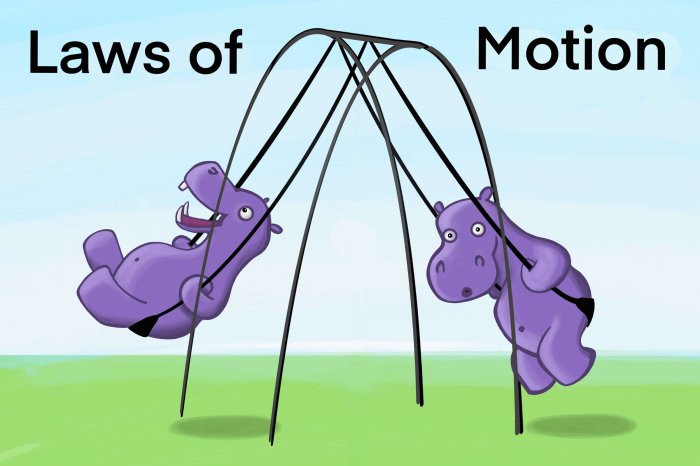
Newton’s laws of motion are not just theoretical concepts; they are fundamental principles that govern the movement of everything around us. They form the bedrock of numerous fields, from engineering to physics and even our everyday lives.
Engineering Applications
Newton’s laws are indispensable in the field of engineering, playing a crucial role in designing and building structures, machines, and vehicles.
- Structural Engineering: Engineers use Newton’s laws to analyze the forces acting on structures, ensuring their stability and safety. For example, understanding the forces exerted by wind and gravity helps in designing bridges, buildings, and other structures that can withstand these forces.
- Mechanical Engineering: Newton’s laws are used to analyze the motion of machines and their components. For example, the design of engines, gears, and other mechanical systems relies heavily on these laws. The second law, specifically, helps in determining the force needed to accelerate a specific mass, which is essential for designing machines that can perform specific tasks.
- Aerospace Engineering: In aerospace engineering, Newton’s laws are crucial for designing aircraft, spacecraft, and rockets. They help in understanding the forces involved in flight, such as lift, drag, and thrust. For instance, the third law explains how rockets propel themselves forward by expelling hot gases in the opposite direction.
Physics Applications
Newton’s laws are fundamental to various branches of physics, including mechanics, astrophysics, and even quantum mechanics.
- Classical Mechanics: Newton’s laws are the cornerstone of classical mechanics, which deals with the motion of objects under the influence of forces. These laws allow physicists to predict the motion of objects, from planets orbiting the sun to a ball thrown in the air. For instance, the first law explains why a ball at rest will stay at rest unless acted upon by a force.
- Astrophysics: Newton’s laws are applied in astrophysics to understand the motion of celestial bodies, such as planets, stars, and galaxies. For example, the second law is used to calculate the gravitational force between celestial objects, which governs their orbits and interactions. The first law explains why a planet continues to orbit the sun in a specific path, without needing an external force to keep it in motion.
Everyday Life Applications
Newton’s laws are at work in many aspects of our daily lives, often without us even realizing it.
- Walking: When we walk, we apply a force to the ground, and the ground exerts an equal and opposite force back on us, propelling us forward. This is an example of Newton’s third law. The first law explains why we keep moving forward once we start walking unless an external force, like friction, stops us.
- Driving: When we accelerate or brake a car, we are applying a force to the car, which causes it to accelerate or decelerate according to Newton’s second law. The first law explains why a car continues to move at a constant speed in a straight line unless a force acts on it.
- Sports: Newton’s laws are fundamental to many sports, such as baseball, football, and tennis. For example, the force applied to a baseball bat determines the speed and direction of the ball. The third law explains why a swimmer pushes off the wall to propel themselves forward.
Limitations of Newton’s Laws: What Are Newton’s 3 Laws
Newton’s laws of motion, while incredibly successful in explaining the motion of everyday objects, have limitations when applied to certain scenarios. These limitations become apparent in extreme conditions such as very high speeds, very strong gravitational fields, or at the atomic and subatomic levels. In these situations, Einstein’s theory of relativity and quantum mechanics offer a more accurate description of motion.
Relativity and High Speeds
Einstein’s theory of special relativity, published in 1905, challenges the Newtonian view of space and time, particularly at very high speeds approaching the speed of light. One of the key postulates of special relativity is that the speed of light in a vacuum is constant for all observers, regardless of their own motion. This leads to some surprising consequences, such as time dilation and length contraction.
Time dilation is the phenomenon where time passes slower for an object that is moving at a high speed relative to a stationary observer.
Length contraction is the phenomenon where the length of an object appears shorter to an observer who is moving at a high speed relative to the object.
For example, a spacecraft traveling at 99% of the speed of light would experience time at a slower rate than a stationary observer on Earth. This means that an astronaut on the spacecraft would age more slowly than someone on Earth. Similarly, the length of the spacecraft would appear shorter to an observer on Earth.
These effects are negligible at everyday speeds, but they become significant as an object approaches the speed of light. Newton’s laws of motion fail to account for these relativistic effects, which are essential for understanding the motion of objects at very high speeds.
Relativity and Strong Gravitational Fields
Einstein’s theory of general relativity, published in 1915, extends special relativity to include gravity. General relativity describes gravity not as a force, but as a curvature of spacetime caused by the presence of mass and energy.
Einstein’s field equations, which are the mathematical foundation of general relativity, describe the relationship between the curvature of spacetime and the distribution of matter and energy.
One of the key predictions of general relativity is that time passes more slowly in a strong gravitational field. This phenomenon, known as gravitational time dilation, has been experimentally verified using atomic clocks.
For example, a clock on the surface of the Earth will run slightly slower than a clock in orbit around the Earth.
Another important prediction of general relativity is the bending of light by gravity. This phenomenon, known as gravitational lensing, has been observed in numerous astronomical settings.
For example, the light from distant galaxies can be bent around massive objects like clusters of galaxies, creating multiple images of the same galaxy.
Newton’s law of universal gravitation, which describes the force of attraction between two objects with mass, fails to account for these relativistic effects of gravity. General relativity provides a more accurate description of gravity in strong gravitational fields, such as those found near black holes and neutron stars.
Quantum Mechanics and the Atomic and Subatomic Levels
Quantum mechanics, developed in the early 20th century, is a fundamental theory in physics that describes the behavior of matter and energy at the atomic and subatomic levels. One of the key principles of quantum mechanics is that energy is quantized, meaning it can only exist in discrete packets called quanta.
For example, an electron in an atom can only occupy specific energy levels, and it can jump between these levels by absorbing or emitting a quantum of energy.
Another important principle of quantum mechanics is the wave-particle duality of matter. This means that particles like electrons can exhibit wave-like properties, such as interference and diffraction.
For example, in the famous double-slit experiment, electrons are fired at a screen with two slits. Even though electrons are particles, they create an interference pattern on the screen, which is a characteristic of waves.
Newton’s laws of motion, which were developed to describe the motion of macroscopic objects, are not applicable at the atomic and subatomic levels. Quantum mechanics provides a more accurate description of the motion of particles at these scales.
Epilogue
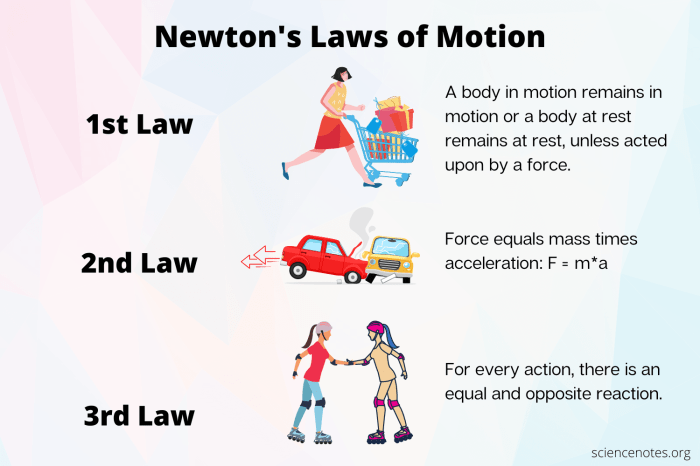
Understanding Newton’s laws is crucial for comprehending the world around us. They provide a framework for analyzing and predicting motion, laying the foundation for further exploration in physics and related fields. While Newton’s laws have limitations in extreme scenarios, they remain a powerful tool for understanding the mechanics of everyday life, from the simple act of throwing a ball to the complex workings of spacecraft.
FAQ Corner
What are some real-world examples of Newton’s laws in action?
Newton’s laws are evident in countless everyday situations. For instance, when you push a shopping cart, you apply a force that causes it to accelerate. When you jump, your feet exert a force on the ground, and the ground exerts an equal and opposite force on your feet, propelling you upward. These are just a few examples of how Newton’s laws shape our experiences.
Are Newton’s laws still relevant in today’s world?
Absolutely! While Newton’s laws have limitations in extreme conditions, they remain the foundation of classical mechanics and are widely used in various fields, including engineering, aerospace, and robotics. They are essential for designing machines, predicting the motion of objects, and understanding the forces at play in countless scenarios.
What are some limitations of Newton’s laws?
Newton’s laws break down at extremely high speeds or in very strong gravitational fields. In such scenarios, Einstein’s theory of relativity provides a more accurate description of motion. Additionally, at the atomic and subatomic levels, quantum mechanics governs the behavior of particles, and Newton’s laws are no longer sufficient to explain their behavior.
